Low-Cost Hyperspectral Imaging with A Smartphone
Abstract
1. Introduction
2. Materials and Methods
2.1. The Hyperspectral Smartphone
2.2. Image Capture and Data Processing
3. Results and Discussion
3.1. Applications
3.1.1. Fruit Quality Control
3.1.2. Volcanic Rock Mineralogy
3.2. Comparisons to A Pre-Existing Low-Cost Imager
3.3. A Field-Portable Low-Cost Hyperspectral Imager
4. Conclusions
Author Contributions
Funding
Data Availability Statement
Acknowledgments
Conflicts of Interest
References
- Stuart, M.B.; Stanger, L.R.; Hobbs, M.J.; Pering, T.D.; Thio, D.; McGonigle, A.J.S.; Willmott, J.R. Low-Cost Hyperspectral Imaging System: Design and Testing for Laboratory-Based Environmental Applications. Sensors 2020, 20, 3293. [Google Scholar] [CrossRef] [PubMed]
- Sigernes, F.; Syrjӓsuo, M.; Strovold, R.; Fortuna, J.; Grøtte, M.E.; Johansen, T.A. Do it yourself hyperspectral imager for handheld to airborne operations. Opt. Express 2018, 26, 6021–6035. [Google Scholar] [CrossRef] [PubMed]
- McGonigle, A.J.S.; Wilkes, T.C.; Pering, T.D.; Willmott, J.R.; Cook, J.M.; Mims, F.M.; Parisi, A.V. Smartphone spectrometers. Sensors 2018, 18, 223. [Google Scholar] [CrossRef] [PubMed]
- Ju, Y.G. Fabrication of a low-cost and high-resolution papercraft smartphone spectrometer. Phys. Educ. 2020, 55, 035005. [Google Scholar] [CrossRef]
- Wilkes, T.C.; McGonigle, A.J.S.; Willmott, J.R.; Pering, T.D.; Cook, J.M. Low-cost 3D printed 1nm resolution smartphone sensor-based spectrometer: Instrument design and application in ultraviolet spectroscopy. Opt. Lett. 2017, 42, 4323–4326. [Google Scholar] [CrossRef] [PubMed]
- Kim, S.; Kim, J.; Hwang, M.; Kim, M.; Jo, S.J.; Je, M.; Jang, J.E.; Lee, D.H.; Hwang, J.Y. Smartphone-based multispectral imaging and machine-learning based analysis for discrimination between seborrheic dermatitis and psoriasis on the scalp. Biomed. Opt. Express 2019, 10, 879. [Google Scholar] [CrossRef] [PubMed]
- Ding, H.; Chen, C.; Zhao, H.; Yue, Y.; Han, C. Smartphone based multispectral imager and its potential for point-of-care testing. Analyst 2019, 144, 4380–4385. [Google Scholar] [CrossRef] [PubMed]
- Bandara, W.G.C.; Prabhath, G.W.K.; Dissanayake, D.W.S.C.B.; Herath, H.M.V.R.; Godaliyadda, G.M.R.I.; Ekanayake, M.P.B.; Vithana, S.S.P.; Demini, S.M.D.; Madhujith, T. A multispectral imaging system to assess meat quality. In Proceedings of the 2018 IEEE Region 10 Humanitarian Technology Conference (R10-HTC), Malambe, Sri Lanka, 6–8 December 2018; IEEE: New York, NY, USA, 2018. [Google Scholar]
- Wang, L.; Jin, J.; Song, Z.; Wang, J.; Zhang, L.; Rehman, T.; Ma, D.; Carpenter, N.R.; Tuinstra, M.R. LeafSpec: An accurate and portable hyperspectral corn leaf imager. Comput. Electron. Agric. 2020, 169, 105209. [Google Scholar] [CrossRef]
- Hegyi, A.N.; Martini, J. Compact hyperspectral image sensor based on a novel hyperspectral encoder. In Next-Generation Spectroscopic Technologies VIII; International Society for Optics and Photonics: Washington, DC, USA, 2015; Volume 9482, p. 948214. [Google Scholar] [CrossRef]
- Lin, J.L.; Ghassemi, P.; Chen, Y.; Pfefer, J. Hyperspectral imaging with near-infrared-enabled mobile phones for tissue oximetry. In Optics and Biophotonics in Low-Resource Settings IV; International Society for Optics and Photonics: Washington DC, USA, 2018. [Google Scholar] [CrossRef]
- Wilcox, C.C.; Montes, M.; Yetzbacher, M.; Edelberg, J.; Schlupf, J. An ultra-compact hyperspectral imaging system for use with an unmanned aerial vehicle with smartphone-sensor technology. In Micro- and Nanotechnology Sensors, Systems, and Applications X; International Society for Optics and Photonics: Washington, DC, USA, 2018. [Google Scholar] [CrossRef]
- He, Q.; Wang, R. Hyperspectral imaging enabled by an unmodified smartphone for analysising skin morphological features and monitoring hemodynamics. Biomed. Opt. Express 2020, 11, 895–910. [Google Scholar] [CrossRef] [PubMed]
- Park, S.M.; Visbal-Onufrak, M.A.; Haque, M.; Were, M.C.; Naanyu, V.; Hasan, K.; Kim, Y.L. mHealth spectroscopy of blood haemoglobin with spectral super-resolution. Optica 2020, 7, 563–573. [Google Scholar] [CrossRef] [PubMed]
- Stuart, M.B.; McGonigle, A.J.S.; Willmott, J.R. Hyperspectral Imaging in Environmental Monitoring: A Review of Recent Developments and Technological Advances in Compact Field Deployable Systems. Sensors 2019, 19, 3071. [Google Scholar] [CrossRef]
- Public Lab. Papercraft Spectrometer Intro Kit. Available online: https://publiclab.org/wiki/papercraft-spectrometer (accessed on 3 April 2021).
- Wang, L.J.; Chang, Y.C.; Ge, X.; Osmanson, A.T.; Du, D.; Lin, Y.; Li, L. Smartphone optosensing platform using a DVD grating to detect neurotoxins. ACS Sens. 2016, 1, 366–373. [Google Scholar] [CrossRef]
- Stanculescu, F.; Stanculescu, A. Polycarbonate-based blends for optical non-linear applications. Nanoscale Res. Lett. 2016, 11, 1–3. [Google Scholar] [CrossRef] [PubMed][Green Version]
- Lee, Y.S.; Chen, W.J.; Huang, J.S.; Wu, S.C. Effects of composition on optical and electrical properties of amorphous In-Ga-Zn-O films deposited using radio-frequency sputtering with varying O2 gas flows. Thin Solid Films 2012, 520, 6942–6946. [Google Scholar] [CrossRef]
- International Standards Organisation (ISO). TC 135/SC 8: BS ISO 10878:2013 Non-Destructive Testing-Infrared Thermography-Vocabulary; International Standards Organisation (ISO): Geneva, Switzerland, 2013. [Google Scholar]
- Zhu, C.; Hobbs, M.J.; Masters, R.C.; Rodenburg, C.; Willmott, J.R. An accurate device for apparent emissivity characterization in controlled atmospheric conditions up to 1423 K. IEEE Trans. Instrum. Meas. 2019. [Google Scholar] [CrossRef]
- Wolfe, W.L. Introduction to Radiometry; SPIE Press: Bellingham, DC, USA, 1998; Volume 29. [Google Scholar]
- Public Lab. Spectral Workbench by Public Lab, DIY Material Analysis. Available online: https://spectralworkbench.org/ (accessed on 17 April 2021).
- Hossain, A.; Canning, J.; Cook, K.; Jamalipour, A. Optical fiber smartphone spectrometer. Opt. Lett. 2016, 41, 2237–2240. [Google Scholar] [CrossRef] [PubMed]
- Das, A.J.; Wahi, A.; Kothari, I.; Raskar, R. Ultra-portable, wireless smartphone spectrometer for rapid non-destructive testing of fruit ripeness. Sci. Rep. 2016, 6, 32504. [Google Scholar] [CrossRef] [PubMed]
- Solovchenko, A.E.; Chivkunova, O.B.; Gitelson, A.A.; Merzlyak, M.N. Non-destructive estimation pigment content, ripening, quality and damage in apple fruit with spectral reflectance in the visible range. Fresh Prod. 2010, 4, 91–102. [Google Scholar]
- Chivkunova, O.B.; Solovchenko, A.E.; Sokolova, S.G.; Merzlyak, M.N.; Reshetnikova, I.V.; Gitelson, A.A. Reflectance spectral features and detection of superficial scald-induced browning in storing apple fruit. J. Russ. Phytopathol. Soc. 2001, 2, 73–77. [Google Scholar]
- Merzlyak, M.N.; Solovchenko, A.E.; Gitelson, A.A. Reflectance spectral features and non destructive estimation of chlorophyll, carotenoid and anthocyanin content in apple fruit. Postharvest Biol. Technol. 2003, 27, 197–211. [Google Scholar] [CrossRef]
- Burbine, T.H.; McCoy, T.J.; Cloutis, E.A. Reflectance spectra of Aubrites, Sulfides, and E Asteroids: Possibke implications for Mercury. In Mercury: Space Environment, Surface, and Interior; Lunar and Planetary Institute: Houston, TX, USA, 2001. [Google Scholar]
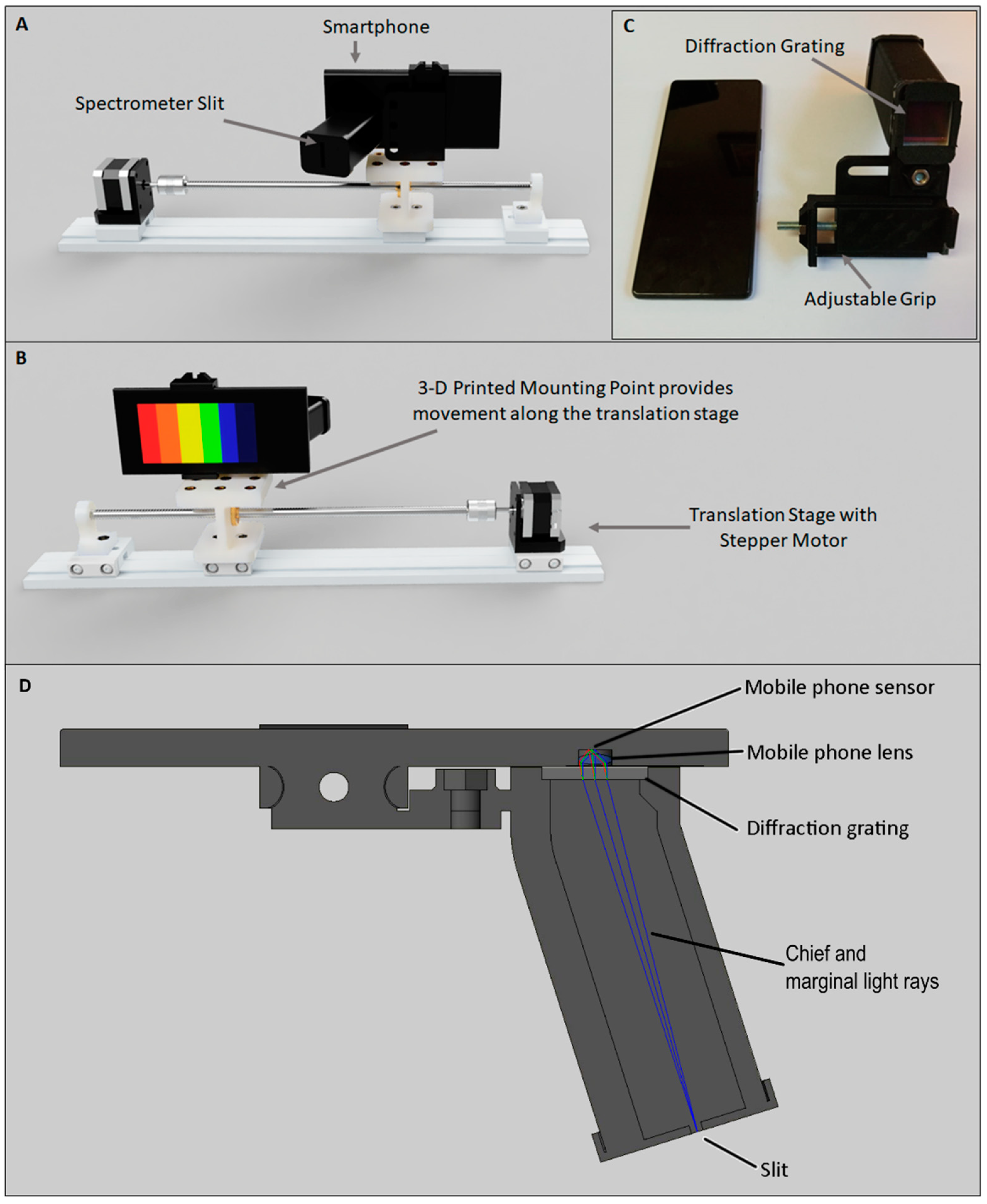
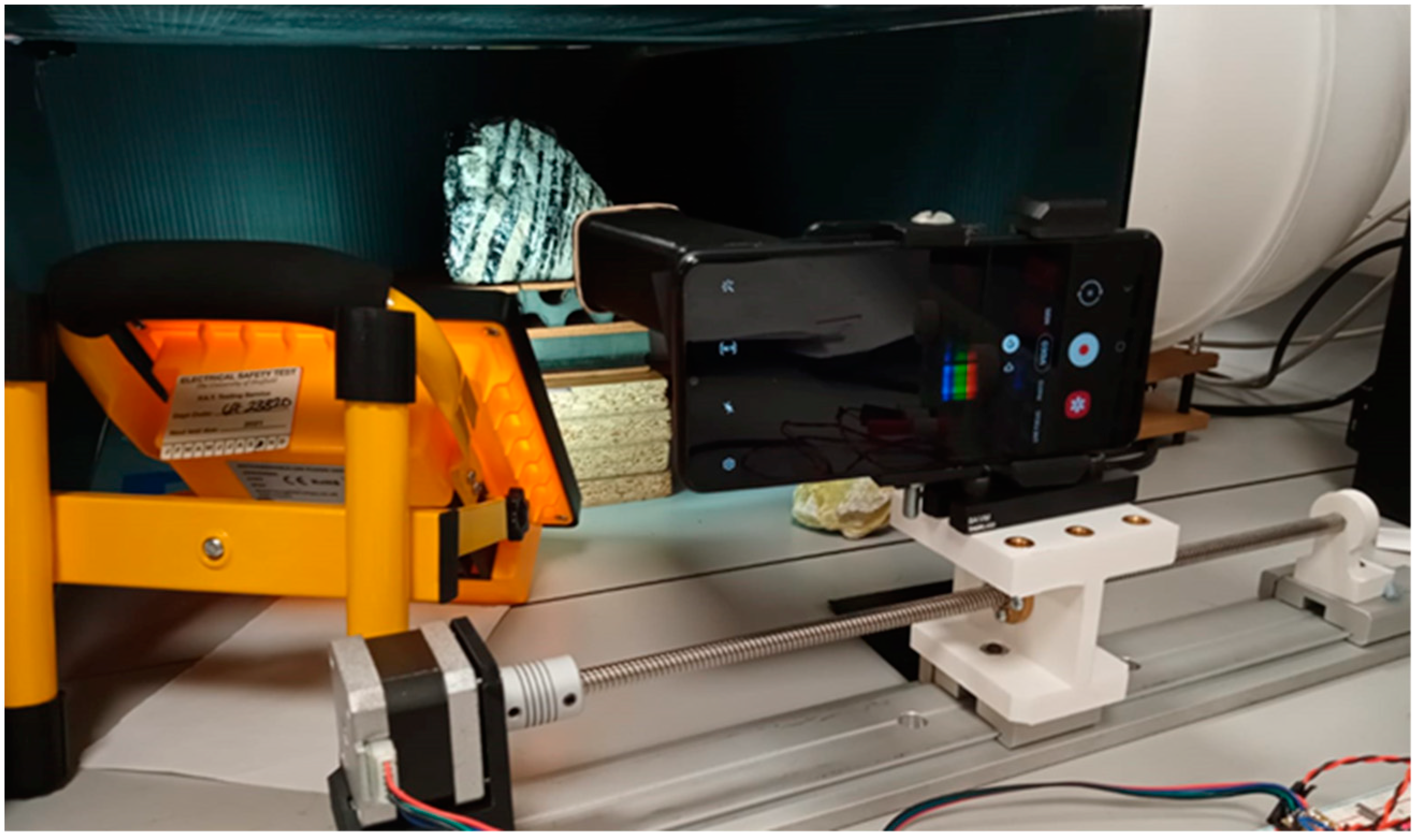


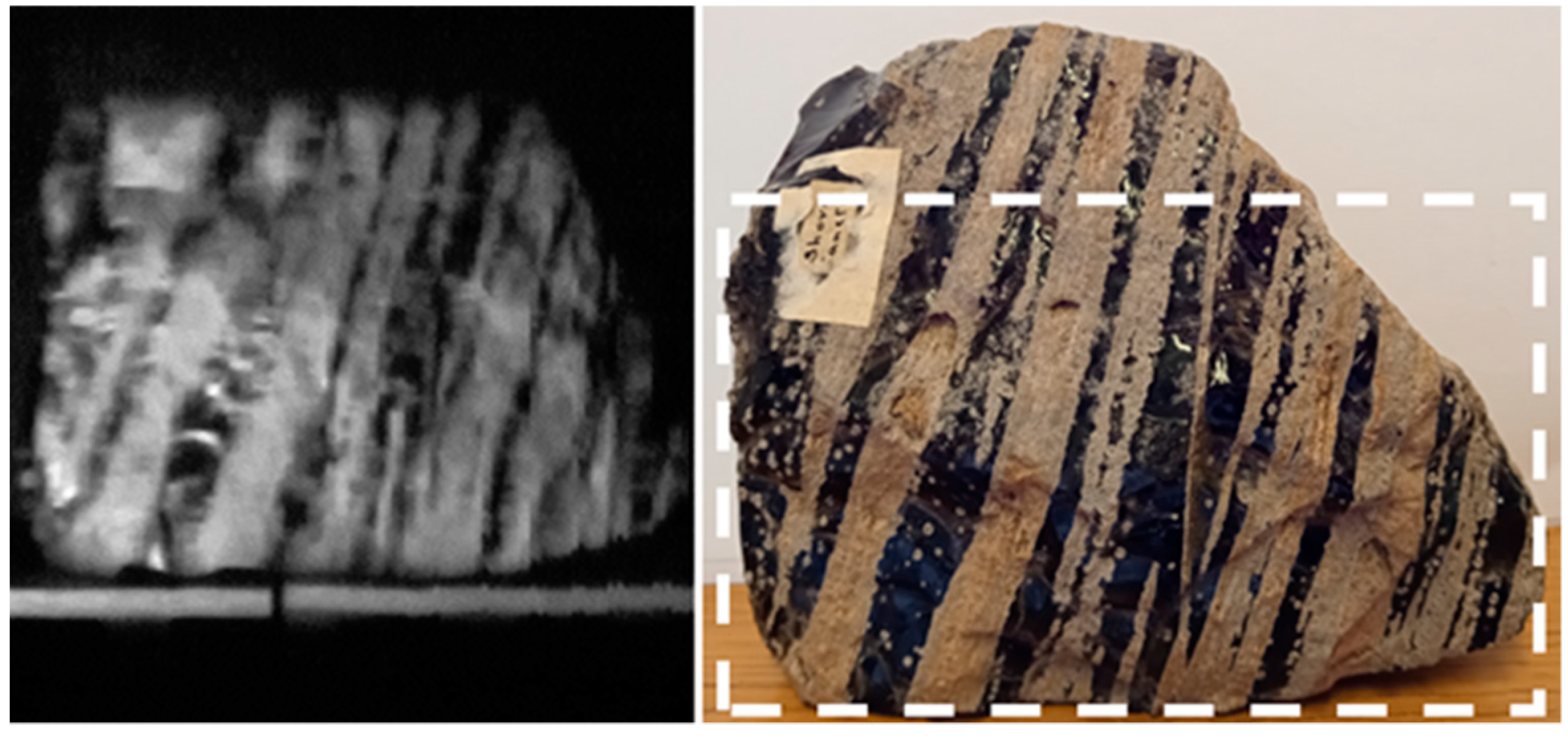
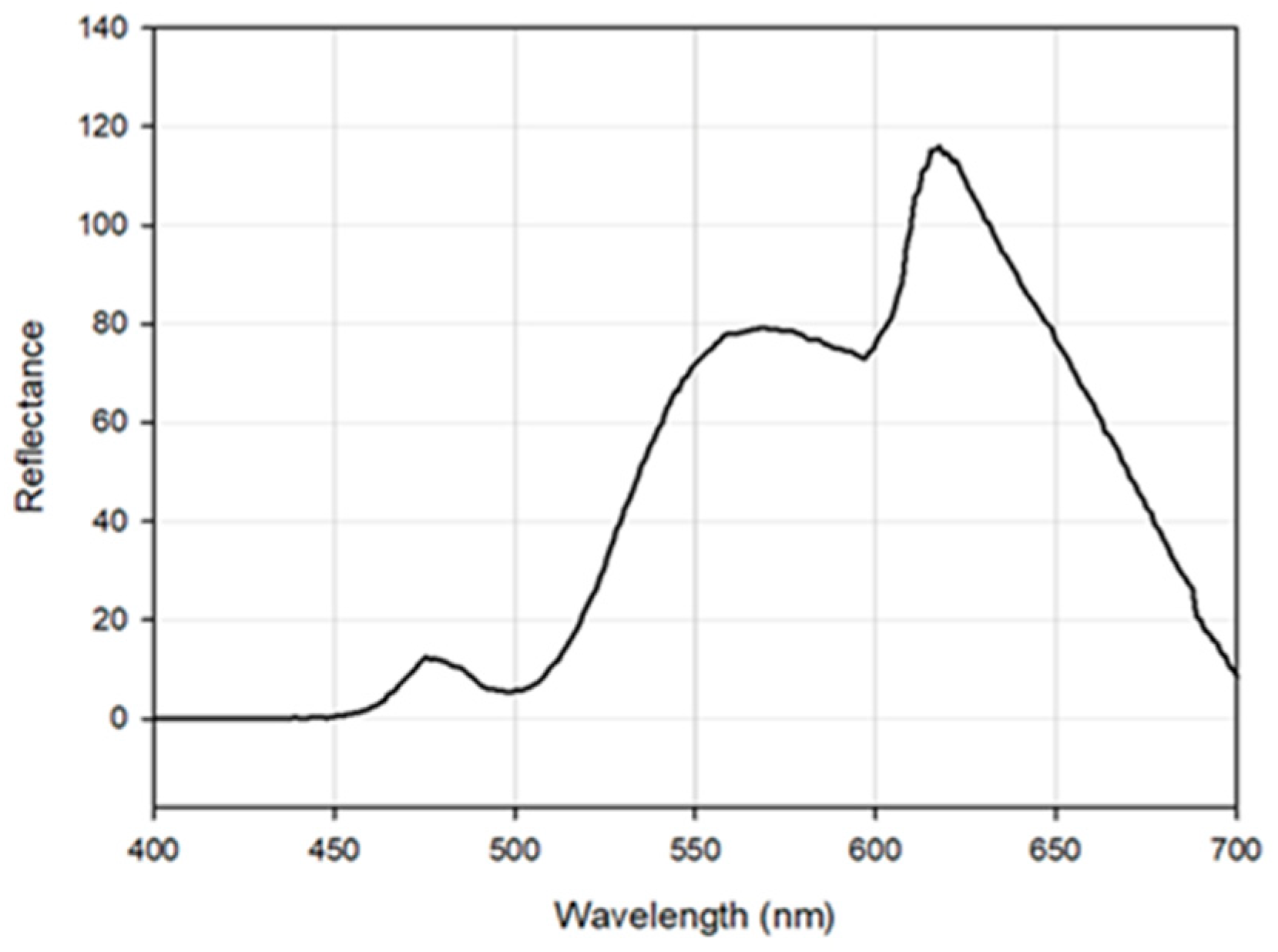


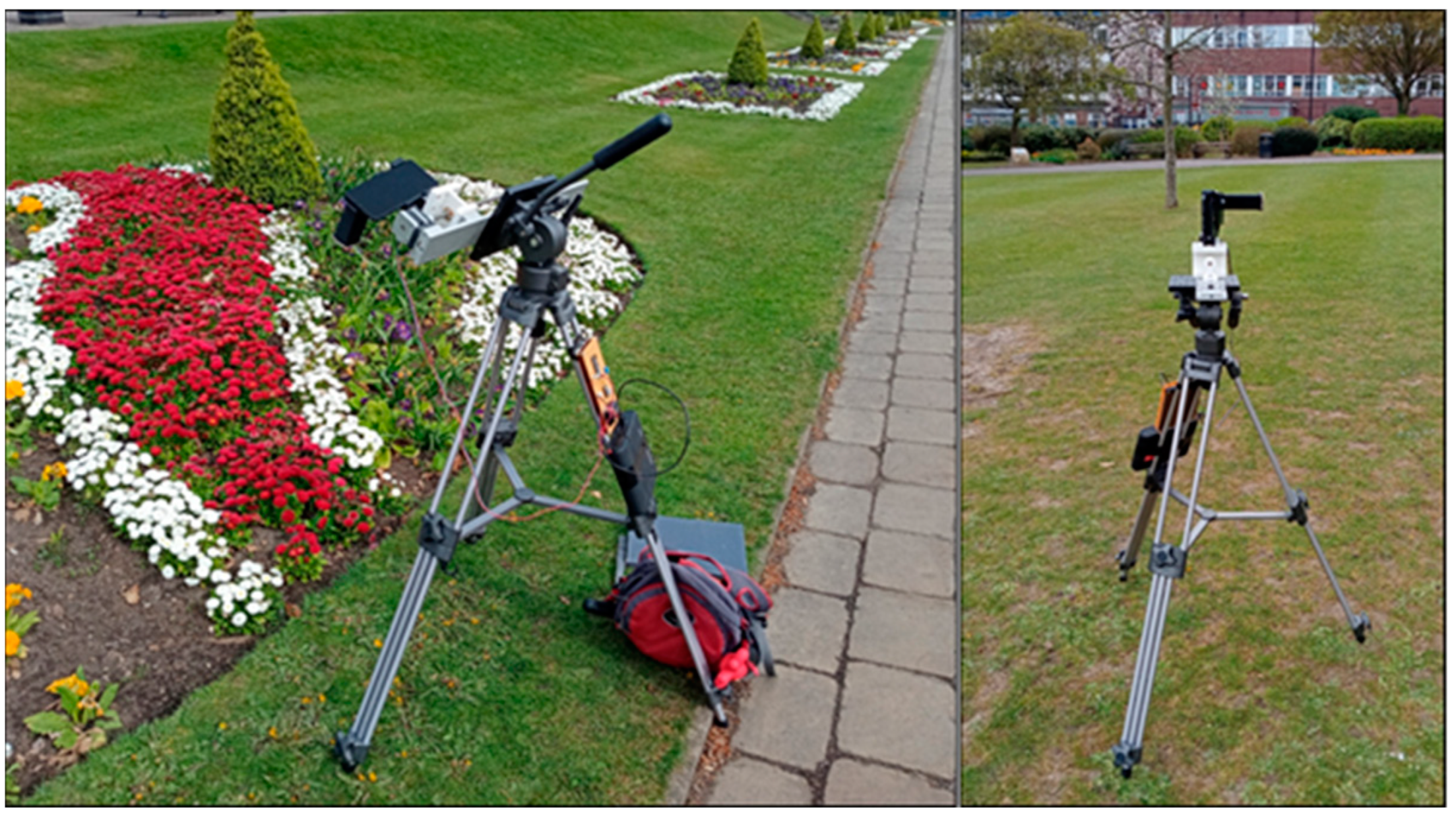

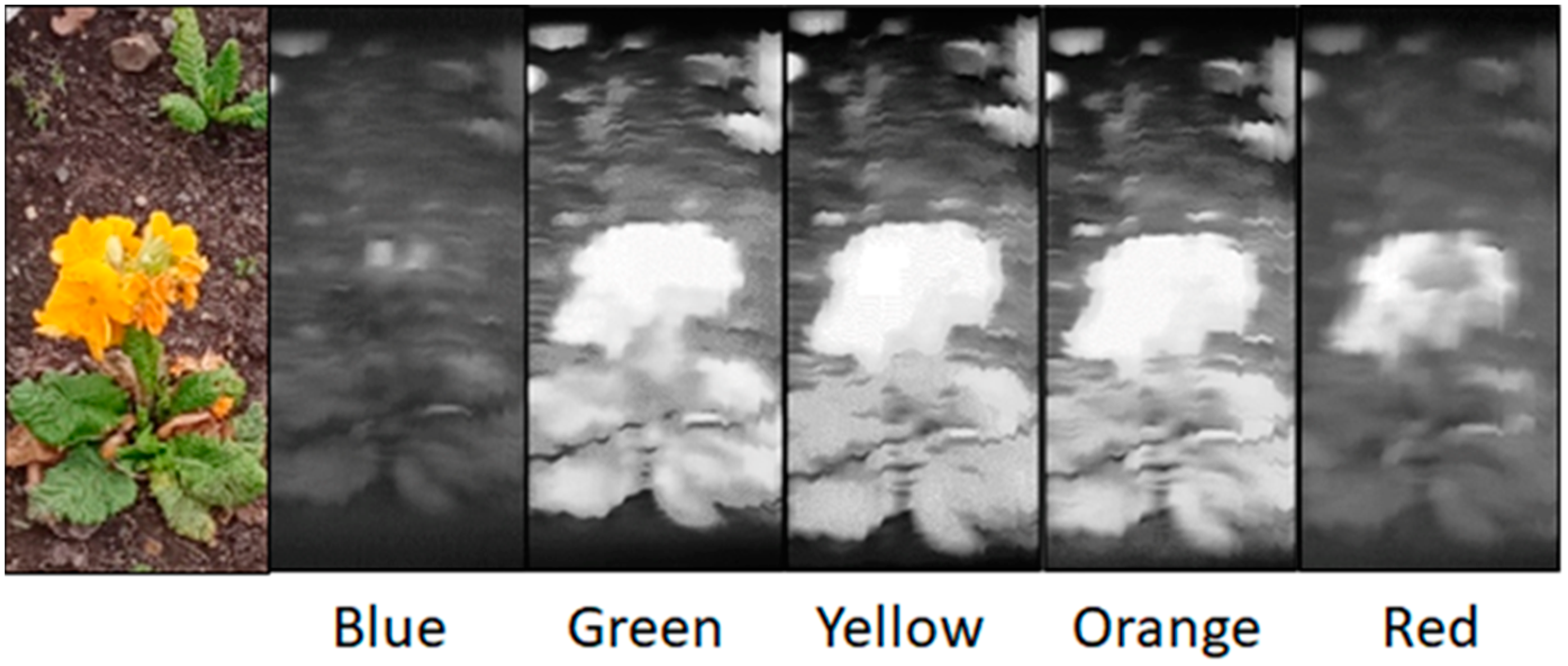

| Samsung Galaxy A12 | |
|---|---|
| Resolution | 48 MP (1920 × 1080 for video) |
| F Number | 2.0 |
| Focal Length (mm) | 26 |
| Fps | 30 |
| Hyperspectral Smartphone | Laboratory-Based Hyperspectral Imager | |
|---|---|---|
| Imaging Mode | Push Broom | Whiskbroom |
| Approximate Cost of Instrument 1 | ~£100 | <£6000 |
| Image Capture Dimensions | Variable—can be modified by the operator. | Variable—can be modified by the operator. |
| Spectral Range (nm) | 400–700 | 340–850 |
| Spectral Resolution (FWHM nm) | 14 | 12 |
| Operator Input Options | Limited. Exposure settings can only be modified within the constraints of the built-in smartphone software. | Variable. Exposure settings and image parameters can be modified by the operator. |
| Potential Portability | Highly portable. Can be deployed anywhere with sufficient lighting. Capable of both indoor and outdoor data capture. | Limited portability within a laboratory setting. |
| Additional Equipment Required for Successful Data Capture | Additional illumination required for indoor data collection, e.g., an LED lamp. A fluorescent light is required to complete the data calibration process. | Additional LED illumination required. Target object placed in a low-cost integrating sphere during data capture. |
Publisher’s Note: MDPI stays neutral with regard to jurisdictional claims in published maps and institutional affiliations. |
© 2021 by the authors. Licensee MDPI, Basel, Switzerland. This article is an open access article distributed under the terms and conditions of the Creative Commons Attribution (CC BY) license (https://creativecommons.org/licenses/by/4.0/).
Share and Cite
Stuart, M.B.; McGonigle, A.J.S.; Davies, M.; Hobbs, M.J.; Boone, N.A.; Stanger, L.R.; Zhu, C.; Pering, T.D.; Willmott, J.R. Low-Cost Hyperspectral Imaging with A Smartphone. J. Imaging 2021, 7, 136. https://doi.org/10.3390/jimaging7080136
Stuart MB, McGonigle AJS, Davies M, Hobbs MJ, Boone NA, Stanger LR, Zhu C, Pering TD, Willmott JR. Low-Cost Hyperspectral Imaging with A Smartphone. Journal of Imaging. 2021; 7(8):136. https://doi.org/10.3390/jimaging7080136
Chicago/Turabian StyleStuart, Mary B., Andrew J. S. McGonigle, Matthew Davies, Matthew J. Hobbs, Nicholas A. Boone, Leigh R. Stanger, Chengxi Zhu, Tom D. Pering, and Jon R. Willmott. 2021. "Low-Cost Hyperspectral Imaging with A Smartphone" Journal of Imaging 7, no. 8: 136. https://doi.org/10.3390/jimaging7080136
APA StyleStuart, M. B., McGonigle, A. J. S., Davies, M., Hobbs, M. J., Boone, N. A., Stanger, L. R., Zhu, C., Pering, T. D., & Willmott, J. R. (2021). Low-Cost Hyperspectral Imaging with A Smartphone. Journal of Imaging, 7(8), 136. https://doi.org/10.3390/jimaging7080136







